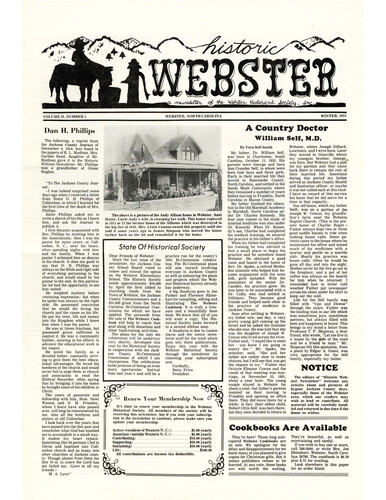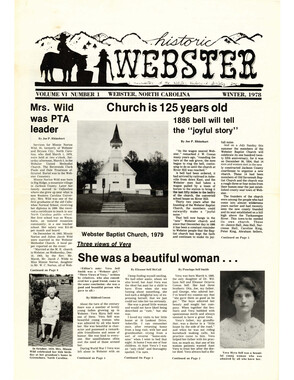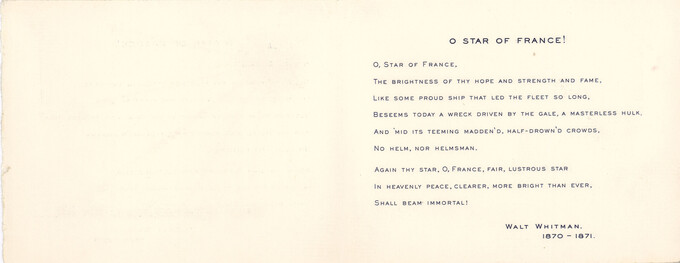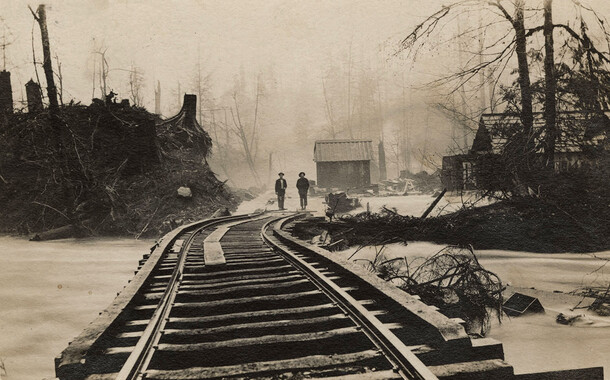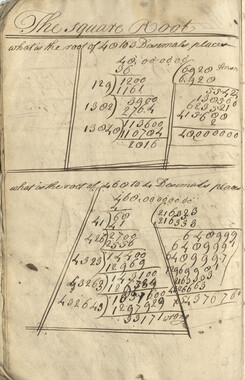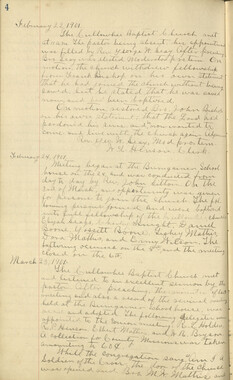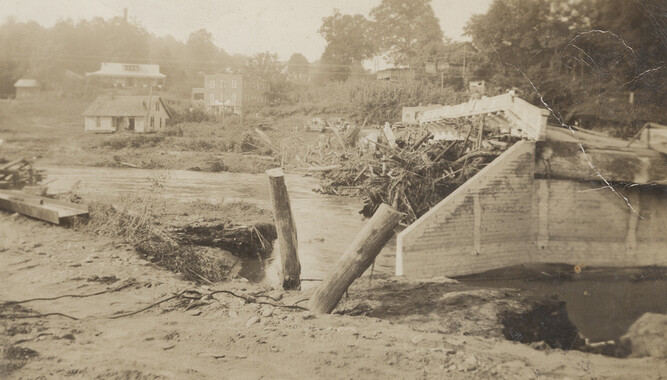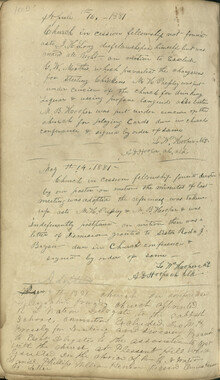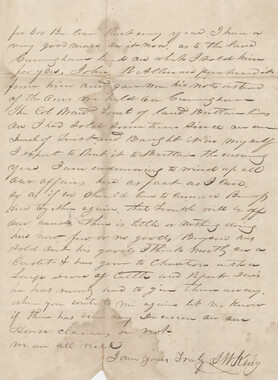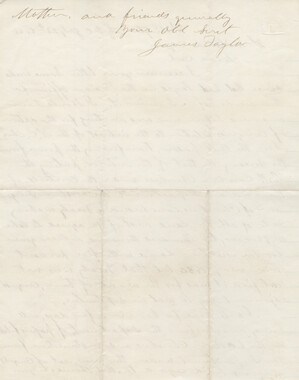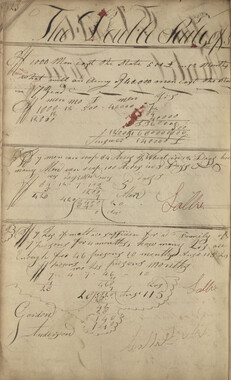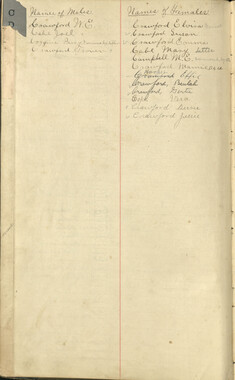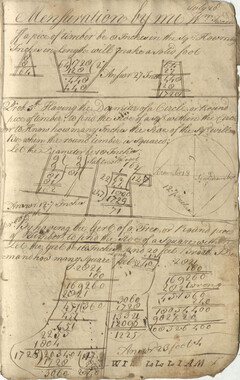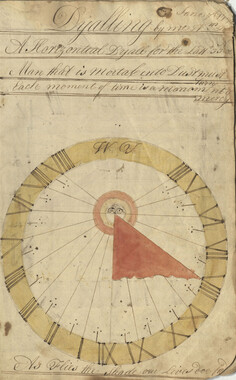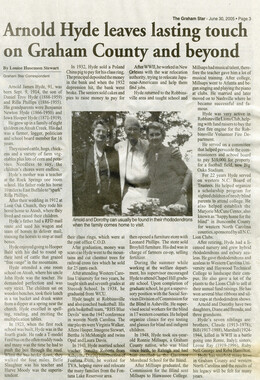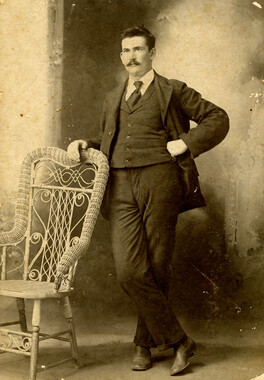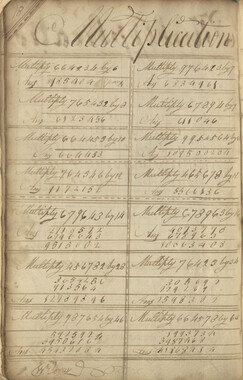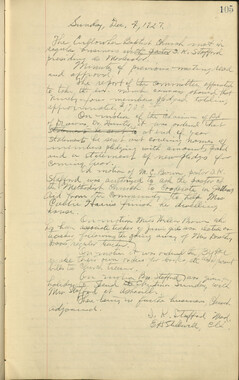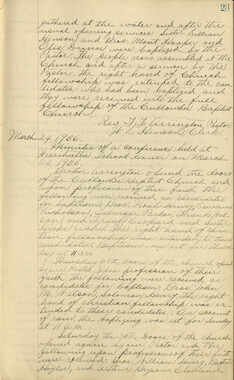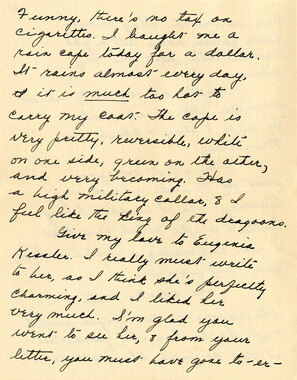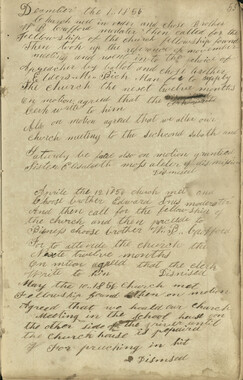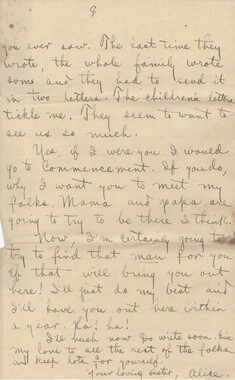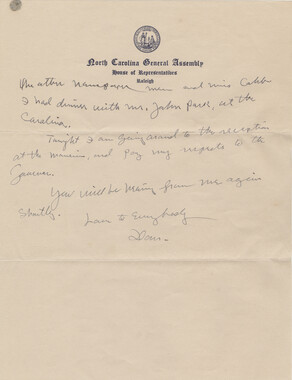Western Carolina University (20)
View all
- Canton Champion Fibre Company (2308)
- Cherokee Traditions (293)
- Civil War in Southern Appalachia (165)
- Craft Revival (1942)
- Great Smoky Mountains - A Park for America (2767)
- Highlights from Western Carolina University (430)
- Horace Kephart (941)
- Journeys Through Jackson (154)
- LGBTQIA+ Archive of Jackson County (24)
- Oral Histories of Western North Carolina (314)
- Picturing Appalachia (6772)
- Stories of Mountain Folk (413)
- Travel Western North Carolina (160)
- Western Carolina University Fine Art Museum Vitreograph Collection (129)
- Western Carolina University Herbarium (92)
- Western Carolina University: Making Memories (708)
- Western Carolina University Publications (2283)
- Western Carolina University Restricted Electronic Theses and Dissertations (146)
- Western North Carolina Regional Maps (71)
- World War II in Southern Appalachia (131)
University of North Carolina Asheville (6)
View all
- Carver, George Washington, 1864?-1943 (26)
- Masa, George, 1881-1933 (8)
- Niggli, Josephina, 1910-1983 (10)
- Whitman, Walt, 1819-1892 (10)
- Wilburn, Hiram Coleman, 1880-1967 (1)
- Allanstand Cottage Industries (0)
- Appalachian National Park Association (0)
- Bennett, Kelly, 1890-1974 (0)
- Berry, Walter (0)
- Brasstown Carvers (0)
- Cain, Doreyl Ammons (0)
- Cathey, Joseph, 1803-1874 (0)
- Champion Fibre Company (0)
- Champion Paper and Fibre Company (0)
- Cherokee Indian Fair Association (0)
- Cherokee Language Program (0)
- Crittenden, Lorraine (0)
- Crowe, Amanda (0)
- Edmonston, Thomas Benton, 1842-1907 (0)
- Ensley, A. L. (Abraham Lincoln), 1865-1948 (0)
- Fromer, Irving Rhodes, 1913-1994 (0)
- George Butz (BFS 1907) (0)
- Goodrich, Frances Louisa (0)
- Grant, George Alexander, 1891-1964 (0)
- Heard, Marian Gladys (0)
- Kephart, Calvin, 1883-1969 (0)
- Kephart, Horace, 1862-1931 (0)
- Kephart, Laura, 1862-1954 (0)
- Laney, Gideon Thomas, 1889-1976 (0)
- McElhinney, William Julian, 1896-1953 (0)
- North Carolina Park Commission (0)
- Osborne, Kezia Stradley (0)
- Owens, Samuel Robert, 1918-1995 (0)
- Penland Weavers and Potters (0)
- Rhodes, Judy (0)
- Roberts, Vivienne (0)
- Roth, Albert, 1890-1974 (0)
- Schenck, Carl Alwin, 1868-1955 (0)
- Sherrill's Photography Studio (0)
- Smith, Edward Clark (0)
- Southern Highland Handicraft Guild (0)
- Southern Highlanders, Inc. (0)
- Stalcup, Jesse Bryson (0)
- Stearns, I. K. (0)
- Thompson, James Edward, 1880-1976 (0)
- United States. Indian Arts and Crafts Board (0)
- USFS (0)
- Vance, Zebulon Baird, 1830-1894 (0)
- Weaver, Zebulon, 1872-1948 (0)
- Western Carolina College (0)
- Western Carolina Teachers College (0)
- Western Carolina University (0)
- Western Carolina University. Mountain Heritage Center (0)
- Williams, Isadora (0)
- 1700s (2)
- 1800s (13)
- 1820s (2)
- 1830s (2)
- 1840s (2)
- 1850s (4)
- 1860s (16)
- 1870s (9)
- 1880s (29)
- 1890s (9)
- 1900s (20)
- 1910s (23)
- 1920s (36)
- 1930s (38)
- 1940s (35)
- 1950s (46)
- 1960s (8)
- 1970s (27)
- 1980s (16)
- 1990s (1)
- 2000s (8)
- 1600s (0)
- 1810s (0)
- 2010s (0)
- 2020s (0)
- Buncombe County (N.C.) (10)
- Cherokee County (N.C.) (8)
- Graham County (N.C.) (11)
- Haywood County (N.C.) (9)
- Jackson County (N.C.) (151)
- Macon County (N.C.) (32)
- Madison County (N.C.) (1)
- McDowell County (N.C.) (2)
- Swain County (N.C.) (6)
- Appalachian Region, Southern (0)
- Asheville (N.C.) (0)
- Avery County (N.C.) (0)
- Blount County (Tenn.) (0)
- Clay County (N.C.) (0)
- Great Smoky Mountains National Park (N.C. and Tenn.) (0)
- Henderson County (N.C.) (0)
- Knox County (Tenn.) (0)
- Knoxville (Tenn.) (0)
- Lake Santeetlah (N.C.) (0)
- Mitchell County (N.C.) (0)
- Polk County (N.C.) (0)
- Qualla Boundary (0)
- Rutherford County (N.C.) (0)
- Transylvania County (N.C.) (0)
- Watauga County (N.C.) (0)
- Waynesville (N.C.) (0)
- Yancey County (N.C.) (0)
- Artifacts (object Genre) (3)
- Cards (information Artifacts) (2)
- Clippings (information Artifacts) (4)
- Drawings (visual Works) (1)
- Envelopes (23)
- Fiction (general Genre) (1)
- Letters (correspondence) (120)
- Manuscripts (documents) (11)
- Memorandums (9)
- Minutes (administrative Records) (2)
- Newsletters (39)
- Periodicals (39)
- Photographs (221)
- Portraits (54)
- Postcards (10)
- Publications (documents) (7)
- Speeches (documents) (1)
- Tintypes (photographs) (1)
- Aerial Photographs (0)
- Aerial Views (0)
- Albums (books) (0)
- Articles (0)
- Biography (general Genre) (0)
- Crafts (art Genres) (0)
- Depictions (visual Works) (0)
- Design Drawings (0)
- Facsimiles (reproductions) (0)
- Financial Records (0)
- Fliers (printed Matter) (0)
- Glass Plate Negatives (0)
- Guidebooks (0)
- Internegatives (0)
- Interviews (0)
- Land Surveys (0)
- Maps (documents) (0)
- Negatives (photographs) (0)
- Newspapers (0)
- Occupation Currency (0)
- Paintings (visual Works) (0)
- Pen And Ink Drawings (0)
- Personal Narratives (0)
- Plans (maps) (0)
- Poetry (0)
- Programs (documents) (0)
- Questionnaires (0)
- Scrapbooks (0)
- Sheet Music (0)
- Slides (photographs) (0)
- Sound Recordings (0)
- Specimens (0)
- Text Messages (0)
- Transcripts (0)
- Video Recordings (physical Artifacts) (0)
- Vitreographs (0)
- C.W. Slagle Collection (4)
- Sara Madison Collection (144)
- A.L. Ensley Collection (0)
- Appalachian Industrial School Records (0)
- Appalachian National Park Association Records (0)
- Axley-Meroney Collection (0)
- Bayard Wootten Photograph Collection (0)
- Bethel Rural Community Organization Collection (0)
- Blumer Collection (0)
- Canton Area Historical Museum (0)
- Carlos C. Campbell Collection (0)
- Cataloochee History Project (0)
- Cherokee Studies Collection (0)
- Daisy Dame Photograph Album (0)
- Daniel Boone VI Collection (0)
- Doris Ulmann Photograph Collection (0)
- Elizabeth H. Lasley Collection (0)
- Elizabeth Woolworth Szold Fleharty Collection (0)
- Frank Fry Collection (0)
- George Masa Collection (0)
- Gideon Laney Collection (0)
- Hazel Scarborough Collection (0)
- Hiram C. Wilburn Papers (0)
- Historic Photographs Collection (0)
- Horace Kephart Collection (0)
- Humbard Collection (0)
- Hunter and Weaver Families Collection (0)
- I. D. Blumenthal Collection (0)
- Isadora Williams Collection (0)
- Jesse Bryson Stalcup Collection (0)
- Jim Thompson Collection (0)
- John B. Battle Collection (0)
- John C. Campbell Folk School Records (0)
- John Parris Collection (0)
- Judaculla Rock project (0)
- Kelly Bennett Collection (0)
- Love Family Papers (0)
- Major Wiley Parris Civil War Letters (0)
- Map Collection (0)
- McFee-Misemer Civil War Letters (0)
- Mountain Heritage Center Collection (0)
- Norburn - Robertson - Thomson Families Collection (0)
- Pauline Hood Collection (0)
- Pre-Guild Collection (0)
- Qualla Arts and Crafts Mutual Collection (0)
- R.A. Romanes Collection (0)
- Rosser H. Taylor Collection (0)
- Samuel Robert Owens Collection (0)
- Sherrill Studio Photo Collection (0)
- Smoky Mountains Hiking Club Collection (0)
- Stories of Mountain Folk - Radio Programs (0)
- The Reporter, Western Carolina University (0)
- Venoy and Elizabeth Reed Collection (0)
- WCU Gender and Sexuality Oral History Project (0)
- WCU Mountain Heritage Center Oral Histories (0)
- WCU Oral History Collection - Mountain People, Mountain Lives (0)
- WCU Students Newspapers Collection (0)
- Western North Carolina Tomorrow Black Oral History Project (0)
- William Williams Stringfield Collection (0)
- Zebulon Weaver Collection (0)
- Church buildings (1)
- Dance (1)
- Education (13)
- Floods (3)
- Forced removal, 1813-1903 (1)
- World War, 1939-1945 (1)
- African Americans (0)
- Appalachian Trail (0)
- Artisans (0)
- Cherokee art (0)
- Cherokee artists -- North Carolina (0)
- Cherokee language (0)
- Cherokee pottery (0)
- Cherokee women (0)
- Civilian Conservation Corps (U.S.) (0)
- College student newspapers and periodicals (0)
- Dams (0)
- Folk music (0)
- Forest conservation (0)
- Forests and forestry (0)
- Gender nonconformity (0)
- Great Smoky Mountains National Park (N.C. and Tenn.) (0)
- Hunting (0)
- Landscape photography (0)
- Logging (0)
- Maps (0)
- Mines and mineral resources (0)
- North Carolina -- Maps (0)
- Paper industry (0)
- Postcards (0)
- Pottery (0)
- Railroad trains (0)
- Rural electrification -- North Carolina, Western (0)
- School integration -- Southern States (0)
- Segregation -- North Carolina, Western (0)
- Slavery (0)
- Sports (0)
- Storytelling (0)
- Waterfalls -- Great Smoky Mountains (N.C. and Tenn.) (0)
- Weaving -- Appalachian Region, Southern (0)
- Wood-carving -- Appalachian Region, Southern (0)
- StillImage (230)
- Text (200)
- MovingImage (0)
- Sound (0)
Historic Webster Vol. 2 No. 1
-
Historic Webster is a newsletter of the Webster Historical Society, Inc., created at the Society’s founding in 1974. The publication helped to serve the Society's mission of collecting and preserving the history of Webster, North Carolina. Webster, established in 1851, was the original county seat for Jackson County.
-
-
Dan H. Phillips The following, a reprint from the Jackson County Journal of December 4, 1914, was found in the papers of R. L. Madison. Mrs. Gordan Reed, daughter of Mr. Madison gave it to the Historic Webster Newsletter. Mr. Phillips was a grandfather of Glenn Hughes. "To The J ackson County Journal : --1 was indeed surprised some days ago when I received a letter from Sister D. H. Phillips of Cullowhee, in which !learned for the first time of the death of Bro. Phillips. Sister Phillips asked me to write a sketch of his 1ife as I knew him, and ask the Journal to publish it. I first became acquainted with Bro. Phillips by meeting him in the Associations; then I was his pastor for some years, at Cullowhee, N. C., near his home often spending nights with hi~ and his family. When I was pastor I ordained him as deacon in his church . It does me good to say that D. H. Phillips was always on the Bible and right side of everything pertaining to the church, and would stand by his pastor to the end. In this particular we had the opportunity to see him tested. He weighed matters before venturing expression ; but when he spoke was a lways on the right Side·. He possessed conviction that he would die loving his church and the cause as his life. He put his time, life and money mto the Kmgdom while I knew him when I was his pastor. He was at times fractious, but possessed grace sufficient to co~trol it. He was a community builder, untiring in his efforts to advance the educational work in his county. He loved his family as a devoted father , constantly striving to give them the best educational advantages. He loved his brethren of the church and would never fail to urge them at church and association to read the Biblical Recorder, often saying that by bringing it into his home he brought some of his children to Christ. The years of pastorate and fellowship with him, Bros. Newt Watson and D. M. Pressley, whom I learn have also passed over, will long be remembered by me. Also all the brethren and sisters of old Cullowhee. I look back over the years that have passed into the dim past and remember what God has enabled me to accomplish in a small way. It makes my heart rejoice . Something like 60 persons I led to Christ and baptised into Cullowhee church and as many into other churches of Jackson county. Though absent from them for this 10 or 15 years the Lord has not failed me. (Love to all my friends .) M.A. Love" WEBSTER, NORTH CAROLINA '!'he above is a picture of the Andy Allison home in Webster. Aunt ~a the, Uncle Andy's wife, is sweeping her walk. This house replaced m 191_1 o~ 12 the former home of the Allisons which was destroyed in the b~g fire of 1910. Mrs. Lewis Cannon owned this property until she sold It some years ago to James Simpson who moved the house farther back on the lot and remodeled it for his home. State Of Historical Society Dear Friends of Webster· Since the last issue of. the newsletter , the Jackson County School Board voted to renew and extend the option on the Webster Elementary School. The Historic Society needs approximately $19,000 by April the first added to matching funds from the Town of Webster, the Jackson County Commissioners and a $55,000 grant from the North Carolina Bi-Centennial Commission for which we have applied. The proceeds from the sale of The Webster Cookbook will help to reach that goal along with donations and other fund-raising activities. The plans for the July 4th celebration will be underway very shortly, developed this year by the Historical Society m cooperation with the Jackson County Bi-Centennial Commission of which I am chairperson. The celebration holds promise of being an even more spectacular festival than last year's and will be a practice run for the county's 1976 Bi-Centennial celebration. The Bi-Centennial plans will aim toward involving everyone in Jackson County as well as enhancing the plans and projects which the Webster Historical Society already has underway. A big thankyou goes to Joe Parker and Florence Rhinehart for compiling, editing and illustrating The Webster Cookbook. It is truly a treasure and a beautifully done book. We know that all of you wttl want a copy. The Historical Society looks forward to a second edition soon. A thankyou is due to Louise Davis and the entire newsletter staff for the work which goes into these publications. Enjoy this year with the Webster Historical Society throu!\h the newsletter by renewmg your subscription now. Cordially, Betty Price President '~f? ~'s ~ enew Your Membership Now~ _Its ~ime to renew your membership to the Webster H1st~r~cal S?ciety. All members of the society will be r.ece1vmg th1s newsletter, but if you wish your subscription to the newsletter to continue, please make sure you update your membership. Active (resident of Western N. C->: ....... -. ... $5-00 yearly Associate (outside Western N. C->: ........... $5-00 yearly Contributing: ..... $10-00 yearly Supporting : . . . . . .$20.00 yearly Sustaining: . . . . . $30.00 yearly . Life : . . . . . . . . . . . . . . . . . . . . . . . . . . . . . .............. $100.00 ~"' ............ ;·~-· ........... . ·==;/A WINTER, 1975 A Country Doctor William Self, M.D. By Vera Self Smith My father, Dr. William Self, was born m Charleston, South Carolina, October 13, 1852. His parents were George and Sara Ann Crowder Self, to whom were born four boys and three girls. Early in their married life they moved to Buncombe County, North Carolina, and settled in the Sandy Mush Community where they remained a number of years before moving to Franklin, North Carolina in Macon County. My father finished his education in the Old Marshall Academy m Marshall, North Carolina under Dr. Charles Kennedy. His four year course in the study of internal medicine was also under Dr. Kennedy. When Dr. Kennedy's son, Charles had completed his medical training, he entered · the practice in his father 's office. When my father had completed his training he was advised to find a small place to begin his practice and he somehow found Webster. He obtained a good room and board in the home of Rev. Dr. Spake, a retired Methodist minister who helped him become acquainted with the town folk , girls included. With the assistance of the senior Dr. Candler, his practice grew. He was later to be associated with a Dr. Colby who had settled in Dillsboro. They became good fnends and helped each other in the practice of medicine in Jackson County. Soon after settling in Webster, my father saw, one day, a very pretty young girl coming up the street and he asked the minister who she was. He was told that she was the daughter of Joseph W. Cowan who lived across the river. Father said, " I would like to meet her - you know I am going to marry her." Mr. Spake, the minister, said, "She and her father are rather slow to make choices, but I will see that you get the chance to try." Father met Octavie Eleanor Cowan and the result of that meeting was marriage, in November 23, 1881, about a year later. The young couple stayed in Webster for ~bt?ut a year, but father's parents ms1sted on their moving to Franklin and opening an office there. They did move there for a while; in fact , their oldest child Robert Ollis Self, was born there: but they soon decided to return to Webster, where Joseph Dillard, Lawrence, and I were born. Later they moved to Glenville where my youngest brother, George, was born. But Webster had a pull for my parents and they came back there to remain the rest of their married life. Sometime· during this period my fathef· served as Jackson County Healtli ~nd Sanitation officer, or maybe 11 was not called such at this tim~. I have no r ecord of this service but know that he did serve for a time in that capacity. Our old home, which my father butlt, was on a portion of the Joseph W. Cowan, my grandfather's farm near the Webstev Baptist Church. (This is the present home of Charlie Roper.) Father always kept two or three good saddle horses to ride when making house calls. Some patients came to the house where he maintained his office and mixed much of his medicines with a mortar and pestle on a marble slab. Mostly his practice was house calls. Often he would be gone all day and into the night. Mother never let the fire go out in the fireplace, and a pot of hot coffee was always on the hearth for him when he returned. I remember how in bitter cold weather Father put newspaper across his chest under his shirt to keep out the cold. Life for the Self family was filled with "Ups and Downs" through the years. Father was the leading man in our life which was sometimes joys, sometimes sorrows, but always filled with love and happiness at home. This brings to my mind a letter from Pz:ofessor T. F . Shipman, a dear fnend, who wrote, " Let me live in a house by the side of the road and be a friend to man. " Mr. Shipman felt this quotation, from a poem by Ed~ar A. Guest, was very appropnate for the Self family, especially my father. NOTICE The editors of "Historic Webste~ Newsletter" welcome any articles about and pictures of bygone Jackson County days, especially those of the Webster a~ea, which our readers may wish to lend or contribute. All material will be carefully handled and returned in due time if the donor so wishes. Cookbooks Are Available . They're here ! Those long anti- They're beautiful, as well as c1pated Webster Cookbooks are entertaining and useful. on sale. We apologize for the If you wish to buy one or more delay and disappointments for we call 586-5840, or write Mrs. Jo~ knowmanyofyouplannedtogive Rhinehart, Webster, North Carocopies for Christmas gifts. But it lma 28786. The cookbook is $6.24 seems publishers refuse to be plus $.75 for mailing. hurried. At any rate, these books Look elsewhere in this paper are well worth the waiting. for an order blank. .;::;:;:::::::::::::::::::::::::;:;::::::::::::::::::::::::::::::::::::::::::::::::::::::::::::::::::::::::::::::::::::::::::::::::::::::::::::::: Historic Webster, Winter 1975, Page 2 William Dallas Wike by Eddie Marie Wike Sutton In 1906 my father, William Dallas Wike, became the principal of the first graded school in Jackson County, which was established at Webster, and served in that capacity for two years. The school was the first to be graded under a new educational system. After this position, and upon advice of his physician, he left the teaching profession for many years--in fact he taught only four more years in the mid-twenties after having served ten years as Postmaster at Cullowhee. He was born December 18, 1867 at the home of his grandfather, Jacob Wike, at East Laporte, and received some early schooling, for short terms, in a log cabin in Fairfield Valley. At the age of twenty-<>ne he heard that Professor Robert Lee Madison was opening a school at Cullowhee. Having a great longing for learning, he was present on the first day to greet Professor Madison. There were eight students in the first class and · for him it was a very late beginning for an education. After three years schooling under Madison he served a one-year apprenticeship in surveying and engineering at Brockton, Mass. returning the next year to graduate at the second commencement of Cullowhee High School; the forerunner of Western Carolina University. In January 1894 he went to Texas and enrolled at Howard Paine College for teacher training ; later he returned to Cullowhee where he was Director of the Normal Department for six years. I have a copy of Longfellow's "Poems and Ballads" inscribed by Prof. Madison: Presented to W. Dallas Wike By the Students and Fellow Teachers of the Normal Department of Cullowhee High School as a Token of Esteem and a Slight Recognition of His Able Service as Teacher-In-Charge of Said Department Upon the Occasion of His Retirement from that Position, May 16, 1901 After Six Years of Faithful Service. Father represented Jackson County in the 1913 North Carolina General Assembly as a member of the House. While a member he introduced legislation which subsequently provided for construction of the first graded road, Sylva to Cullowhee, in the County. He also obtained passage of bills relating to stock law elections; amending the corporate limits and establishing the boundaries of the Town of Webster and secured an appropriation for the purpose of constructing Joyner Building at Western Carolina University. Some thought this building should bear his name but he declined being thusly honored. A few years prior to his service in the Legislature, a movement was on to have the seat of government moved from Webster to Sylva because of the new railroad being routed through there with no hope of ever getting a railway via Webster. Many citizens requested of my father that he introduce legislation to move the courthouse to Sylva without a referendum. Naturally, there was opposition from the citizens of Webster, but, on the other hand, many citizens thought that since the location of the seat of government also directly affected them in various ways the matter should be brought to a vote of the people. This was the position taken by my father and he introduced WILLIAM DALLAS WIKE 1913 General Assembly House Member Photo 01 January 1913 ~ legislation as set forth in Chapter 153, Public- Local Laws of North Carolina, Session 1913: . AN ACT TO ALLOW THE CITIZENS OF JACKSON COUNTY TO EXPRESS THEIR WILL CONCERNING THE PROPOSED REMOVAL OF THE COUNTY SEAT OF JACKSON COUNTY FROM THE TOWN OF WEBSTER TO THE TOWN OF SYLVA, IN SAID COUNTY, AND TO REMOVE THE CbUNTY SEAT IF A MAJORITY OF TH)'; QUALIFIED VOTERS OF THE COUNTY SHALL FAVOR IT ; AND TO LEVY A SPECIAL TAX FOR THE BUILDING OF A NEW COURTHOUSE AND JAIL. The Act encompassed all essentials of the proposed removal including the method of voting; transfer of records ; site selection (naming a site selection committee consisting of Lee Hooper, John B. Ensley, E. L. McKee, George W. Sutton, Scroop W. Enloe, H. R. Snyder, Chas A. Bird, H. R. Queen ·and Tom L. Jamison); condemnation; special tax for construction ($20,- 000); Town of Sylva contribution (land for site plus $10,000 for construction), etc. The Act was ratified February 24, 1913 and the referendum was held on May 8, 1913 with the results being approximately three to one for removal to Sylva. In March 1896 my father married Mrs. Emma Jane Shelton Hampton, a widow, of Qualla Township and to this union were born seven daughters , I being the youngest. Papa died on October 23, 1940 and Mama passed away August 26, 1954. An editorial, written by Dan Tompkins (a native of Webster?) in the Jackson County Journal under date of October 23, 1940, reads: "In the death , at Six Mile, South Carolina this morning of W. D. Wike, Jackson County lost one of its most useful citizens. As teacher, merchant, lumberman, legislator, churchman and citizen , Mr. Wike contributed a great deal to the permanent good of the county. · "A man born in the county, of pioneer stock, Mr. Wike, in addition to having acquired a splendid education , was endowed with an unusual amount of common sense. He read, studied a great deal , thought things through to his own conclusions, and then acted as he believed to be right." "He contributed a great deal to the progress of the county, was one of the early friends of Western Carolina College and believed profoundly in the fundamentals of democracy coupled with sobriety ." "Few sons of Jackson County have given as much to her as this son of vision. He made the county a better place in which to live, and therefore has not lived in vain. He was one of those who wrought well and unselfishly for the good of his county and her people." Gleanings From W ehster Methodist Church Records Register of Marriages I. Henry Smith Ola Sheltop 2. John C. Frizzell Dean Mason 3. Billy Davis Olive Norton Married by C. H. Clyde C. H. Clyde D. R. Proffitt Register o£ Children's Baptisms Child I. Felix Eugene Alley John Hayes Alley Edna Louise Alley 2. Dorothy Moore Parents F. E. and Vira Alley Walter E. and Laura Moore 3. Daniel Moore Allison Thomas Bragg and Isabella Josephine Allison Eugenia Allison March 10, 1907 December 29, 1907 September 17, 1915 Date Minister Aug. 19, 1906 A. T. Bell Aug. 19, 1906 A. T. Bell Aug. 5, 1906 A. T. Bell My Recollections Of The Webster Court House Isabelle Allison Carlton My first vivid impression of the old brick court house was on the night of the big fire in 1910 "when Webster burned." But the old courthouse stood unmarred as a great, stable, sentinel silhouetted against the flames which seemed to reach to the sky as I looked from the yard and street in front of the home of my mother, Mrs. Eugenia Moore Allison. Men and boys were busy carrying our furniture to the foot of the hill behind the house near cemetery road, for we feared that all of Webster would burn. Being only five years old, I had been dressed and carried into the yard before I was fully awake and when I saw the face of the earth light as day from the flames , I was quite sure that it was indeed "the end of time" which according to my elders would surely come. My grandfather, Daniel Killian Moore, worked in some office in the court house. I believe it was the clerk of the court. Occasionally I visited him briefly there and as the court house seemed enormous and rather awesome, I was on my best behavior. Sometimes I would encounter such friends and relatives as Cousin Walter Moore, Mr. Coleman Cowan, Mr. John Jones, and Mr. Gribble. (I called him "Mr. Susie" since the Gribbles were our neighbors and I called his wife "Miss Susie" .) He would give me a friendly greeting and a pat on the head. When I was of school age and court was in session, I was instructed by my mother to walk straight down the street, and to look neither to the right of the left, as court brought crowds of people to Webster with many of the men chewing tobacco and telling tall tales as they sat in front of the buildings along the street. I'm sure the sheriff was nearby to curtail the drinking, cursing and fighting, but I was told to stay close to Ruth and Dan, my sister and brother, as we wended our way schoolward. The Indian women in their native dress peddling bead work , pottery and basketry, added interest and color to Webster during Court Week. The Indian men were there in great numbers when one of their tribe was on trial. Once a handsome young Cherokee named, as I remember, Enoch Cucumber was on trial for his life. I think he had murdered a white man and was housed in the Webster jail. One day the jailer allowed me, along with some older girls, including my sister Ruth, to view him through the bars in his cell. I guess he was glad to have the monotomy of his confinement broken, for he talked with us intelligently and in readily understandable English. He was unusually good looking. My Mother must have heard of this episode and turned my thoughts elsewhere, for I remember nothing else regarding him, his trial, or his sentence - if he received one. After the Court House was moved to Sylva in 1913, only the building was left to remind us of the past glories of Webster. It was now a place for birds to roost and children to play in. There were many steps to climb to the tower with big blood stains on one landing and the most magnificant view of Webster and it's surroundings from its tip top. The "Hanging Tree" was still standing "catty"-cornered across the street between the court house and jail. When women were first allowed to vote, the voting was done in the old court house and I tagged along with my Mother for this memorable occasion. The women were teased and laughed at, but they voted anyway, a privilege my Mother cherished for the rest of her life. The tearing down of the old court house was a happy yet sad occasion. It had become an eye sore as naturally it was unkept and afforded only a roost for birds and a play place for children. But it is hard to see an old landmark razed when a person's roots are deep in it and its surroundings. I never realized how deep mine were until my Mother died in 1970 and I began to take care of her home and collections of her lifetime of 92 years. Upstairs in my Grandmother Allison 's old metal barrel-topped trunk was a packet of letters marked "John B. Allison's papers." He died in 1886 and his wife was my Grandmother Re· becca Bryson Allison with whom my father lived until her death on November 28, 1899. He (Thomas Bragg Allison) and my Mother were married December 18, 1899. She cherished the old trunk and its contents which were "off limits" to children in the family. In my grandfather's papers I was surprised and delighted to find the following records and dates of payments to him as contractor for the public buildings, court house and jail, in Webster which I understand had replaced wooden buildings: "We the commissioners appointed by court to settle with G. B. Allison contractor for the public buildings find the payments made to him as follows: Former receipts 5,968.32 John Wilson's receipt 260.00 County allowance 501.48 By E. D. Davis 70.00 Total amount 6,799.80 That amount taken from contract price for said buildings $10,000.00 Deducted from Treasury 6,799.80 Balance due 3,220.20 State Of M. E. Church South In Jackson County The following report (handwritten) was found among some old records of the Webst~r Methodist Church. F. W. Vaughan was the preacher on the Webster Circuit 1870-71: "State of theM E Church South in Jackson County, North Carolina. Value of church property $9000.00. Number of communicants 479. Sabbath school libraries contain 100 volumes. Local teachers 2 oldest communicants , Males - Mark Coleman, 89; Females, Mrs. Temperence Thomas, 97. Indian Mission at New Echola on Soco Creek--<me local Indian teacher and about 100 communicants. Two mission ~ ary teachers have died on this work to wit:-Rev. David King and Rev . Ulrich Keener." N. W. Vaughan Webster, N. C. July 20, 1870 lllrtiiC WUS!U lfiR EDITORS Mrs. Louise Davis Ms. Alice Harrill Dr. Marilyn Jody TYPISTS Mrs. Sara Barret Mrs. Jennie Lou Hunter CONTRIBUTORS Mrs. Isabelle Carlton Mr. Tom M. Davis Mrs. Clara R. Hyder Ms. Betty Price Mrs. Vera Self Smith Historic Webster, Winter 1975, Page 3 Education In Western North Carolina, Nineteenth Century The following is an excerpt from a paper written by Joe Parker Rhinehart in 1958. Robert L. Madison dreamed of following in his father's footsteps as a doctor, but circumstance changed this. " !...know that in January before my graduation, I professed faith in Christ and later joined the church. These two acts .. .l realize now, but could not then ... coupled with a nervous breakdown follow ing graduation, set in operation a succession of influences that eventuated-praise God ! --in settling me for a half century or more in the glorious skyland of 'The Good Old North State,' here to serve as best I could in teaching 'the young idea how to shoot or the young shoot how to ideate."' Madison's brother, Monroe, a graduate of the University of Tennessee, came to Qualla, Jackson County, as an assistant teacher to Mr. W. A. Long. Monroe resigned this job and accepted a position with Dr. Clarke Whittier. He then prevailed upon his brother Robert to come to " Western North Carolina as the promise land." When Madison arrived in 1885, he found a homogeneous population of Celtic, Germanic, and English stock, "what we commonly embrace in the hyphenated term Anglo-Saxon ." These people were sturdy, independent, intelligent, courageous, resourceful , home loving , and patriotic. "My work in the winter and spring of 1886 completed the second school year begun by my immediate predecessors .'' An average of forty students attended Mr. Madison 's first school in Western North Carolina. These forty ranged from beginners to those studying algebra, grammar, history , and Latin. A typical schedule in this mountain school allowed students to recite at least three times a day. The class periods were from ten to thirty minutes in length. All classes above the second reader group recited every lesson five times a week except those classes from Monday to Friday that come after 2:30 p.m. After that hour on Friday, the remainder of the day was devoted to special exercises consisting of declamations, readings, familiar quotations given in memory as the roll was called, and spelling matches. "We had no pencil tablets, no pens, but all used slates and slate-pencils or talc-pencils." A few students used the one blackboard. Oral and written spelling were taught. Composition work included dictation, paraphrasing, spelling, and hand writing. A dictionary class provided drill in spelling and defining. Latin was optional. For physical education the boys ran, jumped, and played baseball. Marbles, "tap hand" and prisoner's base were played by both sexes. Punishment, neither cruel or excessive, was limited to boys under fourteen. Most students were weB disciplined, seriousminded, and anxious to learn. The schools were only open for two or three months a year. Professor Madison saw that these schools would never be able to prepare teachers. The pay was not appealing to the young teacher. Women teachers received $15.00 a month. Men usually were paid $20.00 to $25.00 a month. But the uneducated farm laborer received $15.00 a month plus board. These conditions began Madison 's crusade for better schools. In the spring of 1886, he visited families of the Qualla community to arouse their interest in a better school. He was successful in getting a community meeting called. The purposes of the meeting were to increase membership of the official board, reorganize it, and to take steps to enlarge the school building. All three proposals passed and a subscription list was started. When the report came back, enough interest was shown to begin construction on the new wing of the building. The work was often halted to allow the workmen to return to their fields. By August 4, the school opened with an additional teach-er. Soon a literary society was organized in which declamations, readings, and debates were emphasized. The teachers acted as critics. The weekly meetings. were enlivened by instrumental music. The spring term ended in May with "elaborate exercises." A sermon, debates, a variety of features--drills , plays, music-and declamations were presented. "The students had been interested and their progress had been most gratifying. The reputation of the school had spread and prospects for another session were promising, provided that the enlarged building should be completed and increased local interest could be aroused. " But these things moved slow and many young people left school to marry or get jobs. Madison found the dialect of the mountains "quaint and interesting," but as an English teacher he must change it. "In some instances, when I was about to condemn to death one of these expressive words , I felt a twinge of guilt or shame, such as I might feel in uprooting a pretty wildflower to substitute a cultivated one. As indisputable indication of the Anglo-Saxon origin of our Carolina highlanders, I noticed in the speech of the good peopie around me many words that one finds in the King James Version brief composition with attention ROBERT L. MADISON to punctuation, paragraphing, lll(:::::::~::===::::=::=:=:=~=::=:=::::=::::::::::::::::: Order Form ::::::::::::::::::::::::::::::::::::::::::::::::::::::::::::7::::::\l\l 1:::: Drawer W d- :::: Webster, North Carolina 28788 1 :::: Enclosed is$ , Send me copies of THE :::: I:::: :W E:B:S!T,E R COOKBOOK at $6.00 plus .75 for wrapping and mailing, North :::: :f:;!:~:\i11h;· .~;:· ,;-,~;,;,,~::::;~:.r::-'~\:. ·::::;.;:.,:~~ I I :~;YRESS STATE ZIP I ::::::::::::::::;:::::;:;:;:;:;:;:::::;:;:;:;:;:::;:::::::::::::::::::::::::::::::::::::::::::::::::::::::::;:;:;::::::::::::::::::::::::::::::::::::::::::::::::;:;:;:;:;:;:::::::::::::::::::::::::::::::::::::::::::::::::: of the Bible or in Chaucer." At the Qualla school, written and oral spelling and English grammar were stressed. Correctness of speech--oral and written-was stressed, but speech habits Were hard to break. "We were able to inculate the fundamental principals and to impress what is meant by reputable usage, but it was difficult for the students to apply their knowledge. However, interest was aroused and some progress was made." School did not open in 1887 because the interior of the building was too exposed for use. Mr. Madison remained in the Qualla community till January. Then he was engaged as a teacher in Sylva. When the Qualla neigh-borhood found he had moved to Sylva, they made attempts to stop him, by putting a man to work kiln-drying the interior finishing, but it caught fire and burned. Interest declined and the establishment of a permanent school ''under my direction seemed a forbidden realization. I had failed but 'hope springs eternal in the human breast' and I did not despair of accomplishing a purpose, if not there, else where in the county." From the two school sessions (1886-1887 ) at Qualla came one editor and author, one preacher, two lawyers, two legislators, two merchants, three county superintendents, twenty teachers, and many farmers and home makers. ~+--~~~ 0 Webster Honor Roll 0 The following is part of a series of articles written quite a number of years ago, by Prof. Robert L. Madison, who very modestly omitted himself and his wife from the list of citizens he named. If we were compiling ·these names today those of Robert Lee and Ella Richards Madison, cofounders of Western Carolina University , would certainly be included. Mrs. Madison will be remembered as a teacher of piano and art to many Webster youngsters in school or in private lessons. "Among those whose efforts and influence have made possible the Webster of yesteryear and today may be named the following: Capt. William A. Enloe, Confederate veteran , successful merchant, and typical Southern gentleman ; L. Coleman Hall, Sr., active man of affairs and trusted county official (treasurer ); Captain Felix Leatherwood, Confederate soldier, merchant, commercial traveler , and legislator; his wife, Mrs. Annie Leatherwood, loveable hostess of the popular Mountain View hotel ; Nathan Coward, merchant, magistrate, highly respected citizen; his wife, Mrs. Sophia Coward, generous, efficient hostess of the well-known Coward House ; Andy B. Allison, merchant, veteran traveling salesman and banker; W. H. H. Hughes, Confederate veteran (one leg maimed in battle) , teacher, superintendent of county schools, and register of deeds ; Dr. W. C. Tompkins, druggist and editor <Webster Herald ); Dr. William Self, physician and promotor of educa-tion ; Riley i-1. Cannon, superior court judge and man of varied useful interests ; Dr. James M. Candler, physician and legislator ; Captain James W. Terrell, Confederate officer, fluent writer, member of county board of education, longtime friend and government agent of the Cherokee Indians, Captain J. Webb Fisher, Confederate soldier, farmer, and for many successive terms, clerk of court ; Robert McKee, popular merchant, esteemed for his geniality and wit; Walter E. Moore, Ia wyer, legislator, speaker of the state legislature, grand master of theN. C. Masonic Grand lodge, educator and judge of the superior court ; Jack Long, farmer, register of deeds, and county commissioner; C. C. Cowan, teacher, county superintendent of schools, lawyer and legislator ; Polk Allman, farmer and public-spirited citizen ; Oscar B. Coward, farmer, merchant, commercial traveler, legislator, and effective factor in the cause of education ; Joe W. Davis, farmer, county treasurer and member of county board of education ; J. Lewis Broyles, merchant, member of county board of education, church worker, and beloved neighbor; Felix E. Alley , clerk of the court, lawyer, legislator, orator, writer, solicitor, and new judge of the superior court ; T. Bragg Cowan, farmer , deputy sheriff, welfare officer, and member of county board of education; W. R. Sherrill, teacher, county superintendent of schools, member of county board of education and lawyer, and Joe W. Rhinehart, merchant and promotor of good roads." From The Scrapbook . On Monday evening, Dec. I a part of our town people appeared at the front door of the parsonage, apparently with intentions of violence, and by the time this affair was over with , the preacher and his family had a gracious pounding, and one that it will take some time to get over. But we rather enjoy this sort of thing and thank God and take courage. We feel very grateful to the pounders, and pray God's richest blessings upon them. (A pounding was gifts, usually food.) We are starting a new conference year and this is encouraging to us as we start into the responsibilities of the new year. Let us all start right to make this next conference year the best the circuit has ever had. Last year was a good one in many respects. We will give a few figures which will show something of the advance the Webster circuit made over the preceding year: In the year 1902 we had conver-sions, 120. In the year 1901 we do not have the figures. In the year 1901, additions to the church, 6. In the year 1902 additions to the church, 68. In the year 1902 paid to P . E. and P. C. $416.00. In the year 1901 paid to the P. E . and P. C.. .303.50 Gain on preacher's salaries over last year .. ... . . .... .. .. ... 112.58 In the year '91 paid to Con. col.. .64.00 In the year '92 paid to Con. col.. . .. . ... . 173.18 Gain over last year . . 109.18 These figures are ~hough to encourage us to do greater things next year. Let us go forward and do it. We paid oUr assessment on missions and the conference collections in full this year; now let us pay every thing in full next year. Yours truly E. Myers Webster, N. C. Mr. Myers was the Webster Circuit preacher from 1901-1903. Historic Webster, Winter 1975, Page 4 The above is the picture, on Little Savannah Road, of the home of the late Mr. and Mrs. James Cowan, parents of the Rev. Napoleon Cowan; Donald Cowan who was president of the old Jackson County Bank; and Cicero and Coleman Cowan, prominent lawyers. and lived there while rearing their family. Later the property was sold to Mrs. Texas Cole who tore down the old house and built a modern one on the site. This house, at one time, one of the lovely old homes in the Webster area, was later purchased along with the farm by Dennis Higdon. The Higdons restored in part the interior of t~e house The elderly couple in the picture is James and Elizabeth Stillwell Cowan. The Rev. H. N. and Stella Middleton Cowan, and Miss Laura Stillwell are the older adults. The child is Elizabeth Cowan, grand-daughter of Napoleon Cowan. ~~nii!II'IIIIIIIDY Dlllltl'' "East La Porte is believed to have been the fartherest East the Fre~cb traded with the Indians priqrto the French-Indian War." This is what Joseph Keys told me when he first brought me home from Alaska. Joseph Keys had assembled the tracts of land known as the Blackwood Lumber Company Boundary. He was one of the Lumber Barons who opened up wilderness from here to Sitka by establishing industry, railroads and payrolls. I am his daughter. Many years have passed since the French and Indian War of 1754-60 which ended the French control of Canada and The West ; also terminating the trading missions for furs by the Voyageurs across. the "Eastern Portage" to the Blue Ridge fur country which we now call "Canady", under the shadow of Rough Butt. "East La Porte" might have been in fact a French-Language place name at that time. Loosely translated it could mean "the Eastern Door". There was a Huguenot settlement, under the leadership of Coligny, even earlier, planted on the borders of Florida in 1562. That entire group was not annihiliated by the Spanish. We may be indebted to these wanderers for having discovered "The Eastern Door" to Balsam Gap. able to search the collection for items you require". In 1962, Historic Sites Superintendent, W. S. Tarleton, wrote that regarding East La Porte's becoming an Historic Site, "You may have a very difficult problem which no amount of research would solve." But, as we keep plugging, written documents and maps are discovered as interest grows. Possibly the original name of East La Porte might have been "C'est La Porte", later to be partially Anglicized to the present day usage. We cannot even be certain that it is of Gallic origin , as the Spanish were here also. French coins , minted with center cut-out holes were unearthed in excavating and laying footings for the I!Iackwood Double-Band Sawmill :at East La Porte. A few of these piers of concrete are still discernable among a thicket of Locust trees on Caney Fork Creek. They appear to be the remains of a ruined fortress rather than the underpins of the largest Double Band-saw Mill ever operated East of the Rockies. What predated this mill here? Who lost those old French coins? and quartz "scrapers", used for dressing hides, are plentiful in the fields there. The profusion of remains indicates either a long term occupation or a multitude during a short interval . This is for an educated investigation to tell us. We do not know where the Cherokee early homeland was, nor who was already here to meet them upon arrivaL There is some belief in the theory that a NeoLithic Culture was still intact here at that time , but the "Old Ones" of the Cherokee Myths may have been entirely different, still to be identified. What did they name these serene mountains and their cities'? Perhaps the Bi-Centennial of 1976 will mark an era of rediscovery on the frontier of Time, The human mterest story of the Land-of-the-Sky surely will be found. Respectfully submitted to the Webster Historical Society Webster, N. C. Elizabeth Keys Nov. 1974 Drawer W LETTERS TO THE EDITOR I have been gone for so many years, since 1921, that much escapes my memory. I graduated in 1919. · Ruth Allison, like her mother and sister Isabelle, was a lovely person. It seems that she taught at first and then was principal, but I was not in any of her classes. I wish some one could tell me about my first grade teacher, Miss Bradshaw. I had to walk two and one-half miles to school. My feet would be so cold from walking on that frozen ground that she would hold me on her lap to warm them by the stove. The first day I went to school I had a little bag of hard candy and was eating it when she had me put it on her desk. I was so embarrassed, but I adored her. As each of my brothers next to me, Alvin, Paul and Claude, started to school , Mama would have me lead him across the old covered bridge. She was afraid they would be too venturesome, start climbing and fall into the river. Commencement time was a big event in our lives. In either the first or second grade our part on the program was a "Tom Thumb Wedding" . I was the bride, Dan Allison was the groom, Gene Alley (son of lawyer Alley) was the preacher, Edith Sherrill, Oberia Wild, and were the bridesmaids. I'm not sure about the groom's attendants, but I think one of them was Enloe Moore. Perhaps some one else can supply the names I don't remember. It didn't seem so wonderful to me then becaused I was teased so much, but I wish now that I had a picture of it to show my grandchildren. Sincerely, Clara Rogers Hyder Clinton, Oklahoma Commander Tom Moore Davis, USN, £rom Hagerstown , Maryland, son o£ Billy and Olive Norton Davis, wrote the following to the Webster Historical Society. Unfortunately, at the time my wife and I stopped at the Rhinehart's on December 30th, we were en route back home that same afternoon and could only afford to stop for a few minutes. It is our hope to return to Webster this coming summer at which time we fully intend to spend a day just re-visiting some of the places my Mother and Dad used to take us on Sunday afternoons when I was a very small boy. I was eight years old when we moved from Sylva to Shelby, and as you may well imagine, it is a little difficult for me to remember everything, but MANY of the names are quite familiar to me. My sincere thanks go out to everyone there (Webster) for their many hours (and months!) of tedious research and dedication to a really grand cause. ~:X ~~ 0 Bright Today 0 Bright Today Let me live in thy sunshine alone Looking neither back nor forward The past holds only evil shadows. Ahead waits that great shade Which shall absorb all shadows. 0 Bright Today Thy sun shall make me heedless Of the bitter past and tomorrow's death. The above was written by Claude Coward, one of the sons of 0. B. Coward of Webster. Claude, a gifted man, died after a long period of ill health , in Webster, February 21, 1935. He was fortynine. About Jackson County One of the peculiar things about Jackson county is that it has been a part of 14 counties. it was at one time part of a county that extended from the coast of North Carolina to within 50 miles of the Mississippi river. Thaddeus Dillard Bryson, founder of Swain county, was the first representative from Jackson county in the General Assembly. The first naturalized citizens of Jackson county were Eric Lovedahl , former subject of Oscar I. of Sweden, and James Searle, former subject of Queen Victoria of England. These citizenships were granted in 1859. U. S. Postage PAID We~'!Jr, Pt: ~; In 1967, the celebrated scholar Dr. Joeffre L. Coe replied to my inquiry regarding East La Porte History, by writing," There is discouragingly little reliable History of the East La Porte area". His letter further states that, "Mr. William Powell is compiling a Gazeteer of North Carolina and the only information available to him was that the name "East La Porte" derived from a French Family that moved into the area from South Carolina. He was not able to find out when" . Dr. Coe adds that if any further information regarding the La Porte family is available he will forward same. We heard no more. Also in 1967 the NoFth Carolina State Archivist, Dr. H. G. Jones wrote a reply to inquiry re. East La Porte History, saying in part, "Manuscripts in this collection of Spanish Records which are pertment to the Spanish Exploration m the Appalachian region are in seventeenth and eighteenth Century Spanish, and in a very difficult Handwriting, we are not Further inquiry into our local History will reveal romance and adventures still unimagined. To date, the most we know is relatively nothing. Our history is a patch work , written in several languages and scattered about in distant countries. The Archives in Paris dealing with Mississippi Fur Trade need to be examined for information. Also, De Solo's Confidential Gold Reports to Carlo V, in the Spanish Royal Archives is a likely source. And , for History before the Spanish arrival, the hitherto hidden caverns and mine shafts of the Cherokee will someday reveal the lost culture and place names these people introduced eight hundred years ago to this country. We have not found ' anyone who knows the name of the town which was at East La Porte, when the Cherokee occupied it and left the raven-head medicin pipe, and emerald beryl magic crystal in the meadow. Luther Wike found the medicin pipe when he was a lad ; the crystal is lost to tourists who took it home. Many ceramic pot shards remain, as well as arrow points; Webster, North Carolina 28788 z: ~ "'· '--------U-l ADDRESS CORRECTION REQUESTED
